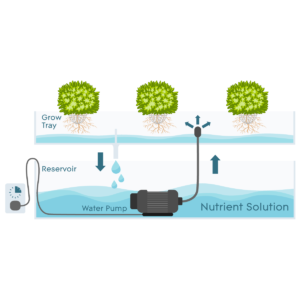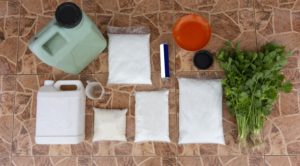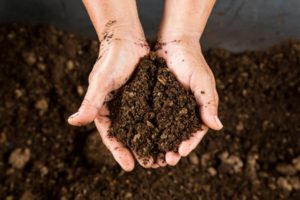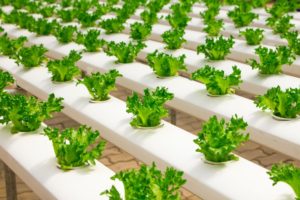Mixing diy nutrient solution for flowering and fruiting stages is different than mixing for vegetative stages. Once plants move on from the vegetative stage, they don’t need as much nitrogen. Instead, they need more potassium and phosphorus to produce blossoms, fruit, and seeds. If you’re growing plants like basil or lettuce, which remain mostly vegetative, you won’t need to worry about this stage. However, most other plants, like tomatoes and peppers, do go through a flowering stage, and then produce seeds, or seeds cased in fruit.
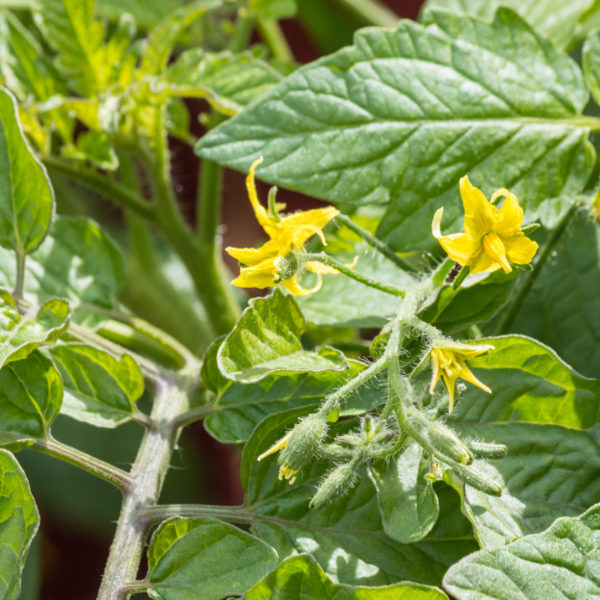
Main Requirements in the Flowering/Fruiting Stage
Nitrogen is crucial when plants need to grow their foliage. However, once plants move on to the flowering and fruiting stages of their lives, they don’t need as much. They begin devoting the majority of their resources and energy to their reproductive phase. Yes, they still need some nitrogen, but not nearly as much. The emphasis switches to phosphorus and potassium, but they also need more of other micronutrients to successfully reproduce.
One notable example is calcium. Calcium is important throughout the plant’s life cycle, but it’s even more important when plants begin flowering. Without sufficient calcium, plants can experience blossom end rot. Blossoms begin deteriorating, and eventually drop, often without producing seeds or fruit.
Learn about the plant growth stages!
Materials and Tools
Make sure you have all your tools and materials ready before you start mixing nutrients. You don’t need anything complicated, and the scale is really the most complex item you need to gather. Whether you buy new tools, or use your old favorites, make sure they’re clean. Like with anything else you do with your hydroponic system, cleanliness keeps plants healthy.
Materials and tools you need:
- 10 gallon bucket for mixing (ideally with a lid)
- Mixing implements (scoop, long handled spoon, whisk, etc)
- Clean work table
- Scale (accurate to .001 g)
- pH and EC testing kits (or digital pen)
- Cups/bowls to hold nutrients
Nutrients for Flowering/Fruiting Recipe
Once you’re sure you have all the tools you need, it’s time to get your nutrients. You can often pick these up online, or at your local garden or hydroponics store. This is a fairly simple recipe, but it will give your plants everything they need. If needed, you can add a supplemental trace element mix. Here are the elements you need to make diy nutrient solution for flowering and fruiting plants.
Nutrients (and amounts):
- Potassium sulfate, .46 grams
- Calcium nitrate, 4.10 grams
- Potassium nitrate, 2.80 grams
- Magnesium sulfate, 2.40 grams
- Monopotassium phosphate, 1.40 grams
- Fe chelated trace elements (7%), .40 grams
How to Mix Your Nutrients
Start with 10 gallons of pure water. Use the purest water possible to avoid extra mineral deposits that can throw your mixture off balance. You don’t need to separate nutrients into separate mixing buckets. That’s because in this recipe, we don’t need to mix and dilute a separate micronutrient solution before it goes into the main batch.
However, you do still need to mix your nutrients one at a time. Don’t mix all your nutrient salts in a bowl and then try to dissolve them in the water. It’s far better to mix each one at a time, even if it takes a little extra time. Whether you measure your nutrients ahead of time and set them aside before you mix is up to preference. However, it’s a good idea, since you can avoid accidentally adding the same nutrient twice, or forgetting to add one.
Add your first nutrient, and make sure it’s completely dissolved in the water. You can manually mix the solution, or seal the bucket and shake it. Either way is fine, as long as the mineral dissolves completely before you add another.
Then, move onto the next nutrient and repeat the same process. You’ll continue this process until you have all the nutrients mixed in a uniform solution.
Test pH and EC
Before you add anything to your system, test your work. Testing your pH and EC doesn’t take long, but it can save you a lot of hassle in the long run. You might need to do a little work to get your levels in the proper range. Keep pH up and pH down products on hand just in case you need to adjust your nutrient solution. These are really easy to use, but don’t get heavy handed with them. A little goes a long way.
The same goes for your EC levels. If they’re too high, they can hurt your plants. A solution that’s much too strong can result in nutrient toxicity or nutrient burn. If your EC is too high, slowly dilute it. Test your solution again after you add any water or adjuster products. You might have to do this a few times, especially when you first start making your own nutrient solution.
What’s next? Add your homemade nutrient solution to your hydroponic reservoir and watch your plants start thriving.
Alternative Nutrient Recipe for Fruiting Crops
The recipe above works well for both flowering and fruiting plants. However, some plants are especially nutrient hungry once they start growing their fruit. These plants need a little extra of certain nutrients, and this alternative formula caters to them.
This recipe is nearly identical to the other, and you’ll go through the same steps to mix and test it. Even the majority of the ingredients (nutrients) are the same. You don’t need to buy any extra nutrients. If you have the supplies from the previous recipe, you already have everything you need.
For the most part, the measurements of the nutrients are the same too. The difference is that we’ll add more of a couple of them. To make it easy, we’ll include the original nutrients and measurements from the recipe above. However, the ingredients with changes in quality will be in bold.
Nutrients and measurements:
- Potassium sulfate, 1.70 grams
- Calcium nitrate, 8.00 grams
- Potassium nitrate, 2.80 grams
- Magnesium sulfate, 2.40 grams
- Monopotassium phosphate, 1.40 grams
- Fe chelated trace elements (7%), .40 grams
As you can see, there’s very little change, and the process is just as simple. With a couple small changes, you can make the perfect fruiting nutrient solution.
